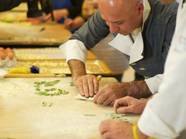AW 139 helicopters - “custom made”. For the Aga Khan who requested it multimedia center, lounging couches and much more inside. But more importantly helicopters for international and government organizations, for emergency medical care, for companies from all over the world, for military clients. All built with the latest technology.
Last Tuesday, I was at the inauguration of the new Augusta Westland plant in Philadelphia, where about 30 AW139 a year will be built. It’s a 30 million dollar investment for 10 thousand square meters of the most advanced machinery. By the end of the years 500 people will be working here to assist the Vergiate (Varese) plant and to fill the world market request – particularly the American market, third in the world of helicopters.
The AW139 is a multi use aircraft: relief operations, transportation, surveillance. Already 300 have been ordered around the world and 110 have been delivered.
It takes about 24 months and between 10 and 15 million dollars, depending on the specifications, to own an AW 139. The “customization” work, the process by which the aircraft is made to order for the client, is one of the things the plant takes most pride in.
Very advanced technology and a smart system that puts online the resources and materials to assemble an aircraft with great attention to details.
Visitors to the plan are sure to be surprised. A vast and modern, almost “artistically” minimalist area, in which different components are prepared for assembly. A long and wide corridor to walk through where we observed how the best of technology is researched and worked on to reach a market that is so difficult and competitive.
Motors, transmissions, rotors, metallic and composite material constructions and much more, ready to be put together in the completed “helicopter system”. A real museum pending on the present. We were taken by the enthusiasm of a child accompanying another guest. In a space so large with different parts of an aircraft spread around like you would have with a model helicopter, it would be impossible not to capture the imagination of a young visitor. And fortunately this time we see the reality of a product created thanks to the resources of our country, which needs to show reasons to be proud, particularly to the younger generations. Finmeccanica is certainly a working Italian reality at the global level, which can be admired on many levels.
taken by the enthusiasm of a child accompanying another guest. In a space so large with different parts of an aircraft spread around like you would have with a model helicopter, it would be impossible not to capture the imagination of a young visitor. And fortunately this time we see the reality of a product created thanks to the resources of our country, which needs to show reasons to be proud, particularly to the younger generations. Finmeccanica is certainly a working Italian reality at the global level, which can be admired on many levels.
At the ribbon cutting ceremony, next to the president and CEO of Finmeccanica Pier Francesco Guargaglini, other high executives of the company was the Italian Ambassador in Washington, Carlo Castellaneta and members of Congress as well as politicians and local authorities.
In the speeches by the American speakers the enthusiasm for this new source of jobs and for the opening that can be created for American companies in the area was evident. Best technology and long-lasting jobs were the key words. "This is a celebration both of the work of AugustaWestland in Philadelphia – noted Senator Robert Casey – and of the creation of hundreds of jobs” and “We are very proud of this plant – said representative Allyson Schwarz – we thank AugustaWestland for having invested in advanced technology”.
 As far as jobs are concerned AugustaWestland employs ten thousand people in plants all over the world, particularly in Italy, Great Britain and the United States.
As far as jobs are concerned AugustaWestland employs ten thousand people in plants all over the world, particularly in Italy, Great Britain and the United States.
The managing director Giuseppe Orsi said the company is involved “in USA programs worth 13 billion dollars over the next five years”, “America represents the world’s third largest market for helicopters, - he added – we have been in Philadelphia for 25 years where we have created a plant that is a model for others – with highly specialized technologies and jobs”. All of this despite the impact of the appreciation of the Euro over the dollar.
AugustaWestland has been in Philadelphia since 1980. Created in 1986 as a 7.000 square meter area dedicated to the maintenance of commercial helicopters in the United States. In 2004 the assembly line for the AW 119 Koala helicopter is housed here.
The growing importance of this plant is also thanks to the training and maintenance services provided. This allows AugustaWestland to provide operating solutions to almost 400 civilian helicopters in US as well.
The Italian Ambassador in Washington, Gianni Castellaneta, in his speech, placed the focus on how the success of AugustaWestland is “a further confirmation of the importance of international cooperation especially during periods of economic difficulty.”
Pier Francesco Guarguaglini said “ the next step will be to increase commercial operation in the United States and improve performance in the sector of electronic defense, where we are weakest.” The assembly line for the smallest helicopter, the single turbine AW119 Ke is already up and running in Philadelphia. Guarguaglini continues: “The decision to build a second line shows how much Finmeccanica and AugustaWestland are committed to investing in the US where today we have more than 2,000 employees”. At the end of his speech he added: “The US remains an important market but we are also looking at other places, like India and Japan.”
It’s worth reminding that in the US, the Charleston (South Carolina) plant for the Boeing 787 Dreamliner program is also where the final assembly for the C-27J for the US Army will take place. Finmeccanica-Augusta is also a partner in the program for the presidential helicopter VH-71 and for the BA609 (New York-Texas).
In the report on the various activities of the company we notice one piece of data among many: Finmeccanica invests resources equal to 14% of profits in Research and Development. Something that many still don't do in Italy.































 a Filadelfia dove abbiamo creato uno stabilimento che è un modello. Con tecnologie e posti di lavoro di alta specializzazione”. Tutto questo nonostante l’impatto dell’apprezzamento dell’euro sul dollaro.
a Filadelfia dove abbiamo creato uno stabilimento che è un modello. Con tecnologie e posti di lavoro di alta specializzazione”. Tutto questo nonostante l’impatto dell’apprezzamento dell’euro sul dollaro. impegnate ad investire negli USA, dove oggi lavorano per noi oltre 2.000 persone”. Poi alla fine del suo intervento ha aggiunto: “Gli Usa rimangono sempre una piazza importante, ma guardiamo anche ad altri mercati, come India e Giappone”.
impegnate ad investire negli USA, dove oggi lavorano per noi oltre 2.000 persone”. Poi alla fine del suo intervento ha aggiunto: “Gli Usa rimangono sempre una piazza importante, ma guardiamo anche ad altri mercati, come India e Giappone”.


 at I have seen the film since her death,” he confesses, overcome with emotion.
at I have seen the film since her death,” he confesses, overcome with emotion. 





 In Trieste, for example, tourists have the opportunity not only to visit synagogues, but also to experience other sites related to Jewish history.
In Trieste, for example, tourists have the opportunity not only to visit synagogues, but also to experience other sites related to Jewish history.